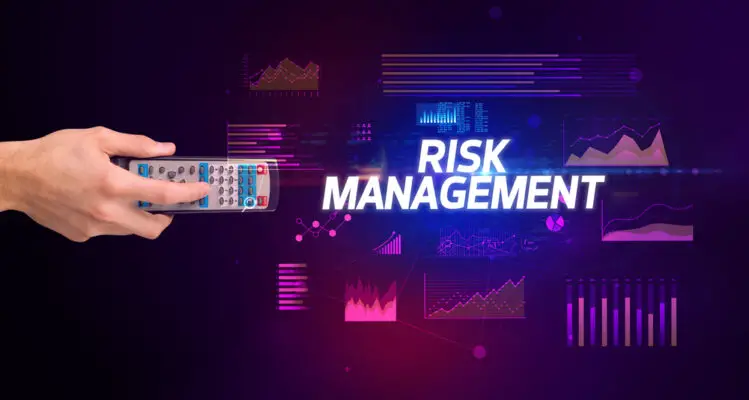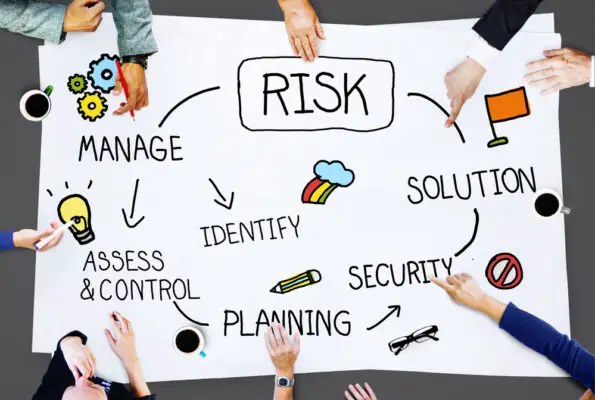Risk management identifies, assesses, and controls risks affecting an organization’s objectives. The goal of risk management is not to eliminate all risks but rather to manage them within the organization’s risk appetite and tolerance.
Risk management is a critical component of any successful business or organization. It involves identifying, assessing, and mitigating potential risks that could negatively impact operations, finances, or reputation.
Effective risk management requires a systematic approach incorporating proactive and reactive measures to minimize the likelihood and severity of risks.
The process of managing risk begins with a thorough understanding of the basics. This includes recognizing different risks, such as financial, operational, legal, reputational, and strategic.
Once identified, each potential risk must be assessed regarding its likelihood and impact on the organization’s objectives.
From there, strategies must be developed to mitigate these risks and plans put in place for implementing these strategies across departments or teams. Ongoing monitoring is necessary to ensure any changes or new risks are accounted for and addressed accordingly.
Through effective risk management practices, organizations can minimise negative outcomes and capitalize on opportunities for growth and success while maintaining their competitive edge in the market.

Understanding Risk Management Basics
The fundamental principles of risk management are essential for individuals and organizations to comprehend to ensure effective decision-making processes.
Risk appetite refers to the level of risk an organization is willing to accept to pursue its goals. It varies depending on organizational culture, size, and industry. Organizations with a high-risk appetite are more comfortable taking risks than low-risk ones.
On the other hand, risk tolerance refers to the amount of uncertainty or loss an organization can tolerate, given its risk appetite. A higher risk tolerance means an organization can withstand greater loss or uncertainty before it affects its objectives.
Effective risk management involves understanding an organization’s overall strategy, identifying potential threats and opportunities, evaluating their likelihood and impact, and developing strategies for managing them based on their significance.
Implementing these strategies through appropriate actions such as avoidance or mitigation measures, monitoring progress towards achieving desired outcomes while adjusting course as necessary based on changing circumstances or new information.
Identifying and Assessing Risks
Through a systematic approach of analyzing potential hazards and evaluating their likelihood and impact, risk identification and assessment can effectively mitigate future uncertainties.
Risk identification techniques involve identifying events or situations that may hurt the organization’s objectives. This process involves collecting information from various sources, including internal sources such as employees, management, and historical data, as well as external sources such as industry reports and government statistics.
Risk assessment frameworks are used to evaluate the potential risks identified during the risk identification process. These frameworks provide a structured approach for assessing the likelihood and impact of each potential risk.
The Likelihood is assessed by considering the probability of occurrence of each event or situation. The Impact is measured in terms of its severity if it occurs. By combining these two factors, organizations can prioritize risks based on their relative importance and allocate resources accordingly.
Effective risk identification and assessment requires a thorough understanding of potential hazards that could impact an organization’s objectives. By utilizing systematic approaches to identify risks through multiple sources, organizations can better prepare themselves for uncertain futures.
Additionally, using established frameworks for assessing risks helps ensure that available resources are allocated wisely to address those risks with higher likelihoods or greater impacts on achieving organizational goals.
Developing Risk Mitigation Strategies
Effective risk management strategies can be developed by utilizing the information gathered during risk identification and assessment, ultimately reducing the potential negative impact of identified risks on an organization’s objectives.
The basic outline of how you can develop risk mitigation strategies:
Understand the Risk: Before developing a mitigation strategy, you must understand the risk entirely. This involves identifying the risk, analyzing its potential impact and the likelihood of its occurrence, and evaluating its relative importance within the context of all the identified risks.
Identify Potential Mitigation Strategies: The next step is identifying possible risk mitigation strategies. This could involve a range of approaches depending on the nature of the risk.
For example, you could implement preventive measures to reduce the likelihood of the risk, create contingency plans to manage the impact if the risk occurs, transfer the risk (for instance, through insurance), or accept the risk if it’s within your organization’s risk tolerance.
Evaluate and Select the Best Strategy: Once you’ve identified potential strategies, you must evaluate them to determine which is most effective. This should consider the cost of implementing the strategy, the potential reduction in the risk, and the potential impact on other areas of your organization.
Implement the Strategy: After selecting a mitigation strategy, the next step is to implement it. This could involve changes to processes, systems, structures, training, or awareness-raising activities.
Monitor and Review the Strategy: After implementing the mitigation strategy, monitoring its effectiveness and monitoring it regularly is essential. This will allow you to make any necessary adjustments and ensure that the strategy effectively mitigates the risk as your organization and its environment evolve.
Developing risk mitigation strategies involves considering all stakeholders involved in the organization’s operations. Stakeholders, including employees, customers, shareholders, and suppliers may have different perspectives on what risks are significant to them and how they should be handled.
Involving stakeholders in developing risk mitigation strategies ensures that their concerns are addressed and helps to increase their buy-in for implementing these strategies.
Contingency planning is a critical component of any effective risk management strategy. Contingency plans provide organizations with a framework for responding to unforeseen events that could negatively impact their operations or objectives.
These plans typically outline steps to respond to specific events or scenarios such as natural disasters, cyber-attacks or financial crises. Organizations can respond more quickly and effectively with a contingency plan when an unexpected event occurs.
Effective risk management requires developing comprehensive risk mitigation strategies involving all stakeholders in an organization’s operations while establishing contingency plans to deal with unforeseen events.
When developing these strategies, it is crucial to consider all possible risks associated with an organization’s activities and the potential impacts these risks could have on its goals and objectives.
Through careful planning and stakeholder involvement, organizations can minimize the negative effects of identified risks while ensuring they are prepared to respond quickly when unexpected events occur.
Implementing Risk Management Plans
To effectively implement these plans, involving stakeholders from various departments and levels within the organization is essential. This ensures that everyone clearly understands the identified risks and potential responses.
Stakeholder involvement is key to successful implementation of risk management strategies. It helps identify potential roadblocks and ensure everyone is aligned with the strategy. Additionally, involving stakeholders can help build buy-in and commitment to the plan.
Once stakeholders are involved, developing specific risk response plans for each identified risk is important. These plans should outline how each risk will be managed, monitored, and mitigated.
Risk response planning involves developing contingency plans for each identified risk so that if it does occur, there are actionable steps to manage its impact on the organization’s objectives. This includes identifying early warning signs for each risk and outlining specific triggers or thresholds when certain actions need to be taken.
Successfully implementing risk management plans requires stakeholder involvement and careful attention to detail in developing effective response plans for each identified risk.
Continuously Monitoring and Adjusting for Risk
Monitoring and adjusting for risk is critical to maintaining a successful risk management plan. Real-time monitoring allows organizations to identify potential risks as they arise quickly, enabling proactive adjustments before the situation worsens.
This process requires constant vigilance and attention to detail, as even minor changes in the environment can create new risks or alter existing ones. Proactive adjustments are also essential in ensuring an organization’s risk management plan remains effective.
As circumstances change, once effective strategies may become obsolete or insufficient.
Organizations must watch for potential risks and adapt their strategies through real-time monitoring and proactive adjustments.

Frequently Asked Questions
What is the difference between risk management and crisis management?
Risk management and crisis management are two distinct but interconnected concepts. While risk assessment is a crucial component of both, the former focuses on identifying and mitigating potential risks before they materialize into crises.
In contrast, the latter deals with managing and containing an unforeseen event that has already occurred.
Prevention strategies are essential in risk management by identifying potential hazards and implementing measures to minimize their impact. Crisis management involves responding promptly to an unexpected situation, minimizing its effects, and restoring normalcy as quickly as possible.
Risk and crisis management require an analytical, detail-oriented, and forward-looking strategic approach. Effective risk management can help organizations avoid or mitigate crises, while effective crisis management can limit the damage caused by such events.
How do you measure the success of a risk management plan?
Key metrics should be identified and tracked over time to measure a risk management plan’s success. These metrics could include the number of incidents or accidents within a specific timeframe, the severity of those incidents, and how much they cost the organization in terms of financial losses or damage to reputation.
It is important to note that risk management is an ongoing process that requires continuous improvement rather than a one-time fix.
Therefore, organizations should regularly assess their risk management strategies and adjust them as needed to mitigate potential risks effectively.
What are some common mistakes to avoid when implementing a risk management plan?
One common mistake is failing to involve all stakeholders in the implementation process, which can result in ineffective risk management.
Another mistake is adopting a reactive approach instead of proactively identifying and mitigating risks.
Organizations should establish clear communication channels with stakeholders, conduct regular risk assessments, prioritize risks based on their impact and likelihood, and develop contingency plans for potential scenarios to avoid these mistakes.
How do you involve stakeholders in the risk management process?
Stakeholder engagement is a critical component of effective risk management. Engaging stakeholders helps ensure that all parties know the risks involved and can work together to develop a comprehensive communication strategy for addressing these risks.
Effective stakeholder engagement involves identifying key stakeholders, understanding their concerns and priorities, and developing a clear plan for communicating with them throughout the risk management process.
This may involve regular meetings or updates and provide stakeholders with relevant information and resources to help them understand the risks involved and how they can contribute to mitigating these risks.
What is the role of insurance in risk management?
The role of insurance in risk management cannot be overstated. By transferring risk to an insurer, businesses and individuals can mitigate potential losses and protect themselves from financial ruin.
Insurance benefits are numerous, including the ability to spread risks across a large pool of policyholders, thereby reducing the impact of individual losses. Additionally, insurance provides peace of mind by covering unforeseen events that may otherwise cripple a business or individual’s financial stability.
Conclusion
Risk management is a vital aspect of any organization’s success. It requires identifying, assessing, and developing strategies to mitigate potential risks that may arise during business operations.
This process involves continuous monitoring and adjustment to ensure that the risk management plan remains effective.
In conclusion, managing risk is not an easy task for any organization. It requires thorough analysis and strategic planning to identify potential risks and develop appropriate mitigation strategies.
Effective risk management involves continuously monitoring and adjusting the plan to ensure it remains relevant and protects the organization from harm.

Chris Ekai is a Risk Management expert with over 10 years of experience in the field. He has a Master’s(MSc) degree in Risk Management from University of Portsmouth and is a CPA and Finance professional. He currently works as a Content Manager at Risk Publishing, writing about Enterprise Risk Management, Business Continuity Management and Project Management.


